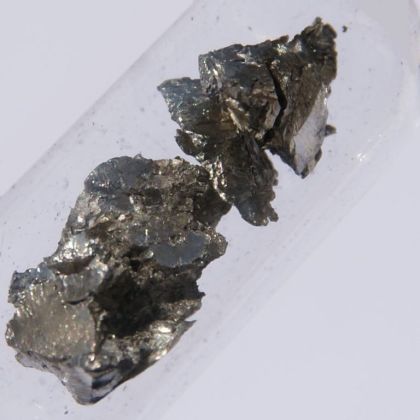Pr • Atomic Number 59

Praseodymium
Praseodymium is a soft, silvery-white paramagnetic metal belonging to the light rare earth elements.
Its unique characteristic is its ability to absorb and scatter light in a very specific yellow-green region of the spectrum. This property is also the origin of its name, derived from the Greek word prásinos, meaning "leek green."
This makes it an important yellow coloring agent and filter in certain types of glass and ceramics.
In 1841, Carl Gustav Mosander extracted the rare earth didymium from lanthanum oxide. In 1874, Per Teodor Cleve observed that didymium was actually composed of two elements. In 1879, Lecoq de Boisbaudran isolated samarium from didymium, which he obtained from the mineral samarskite. In 1885, Carl Auer von Welsbach succeeded in separating didymium into praseodymium and neodymium, whose salts display different colors.
The most important host mineral for praseodymium is bastnäsite, which is the commercially most significant source of the light rare earth elements.
China is the dominant producer. However, bastnäsite is also mined in the USA at the Mountain Pass mine. The Mount Weld mine, operated by the Australian company Lynas Rare Earths, is one of the richest deposits in the world. Lynas runs a large separation facility in Malaysia and is thus the most important alternative supplier of separated rare earths outside of China.
As with all lanthanides, the ores are first concentrated by flotation. Then the metals are converted into their respective halides and separated by fractional crystallization, ion exchange, or extraction. The metal is obtained by molten salt electrolysis or reduction with calcium.

The most important application of praseodymium is its use as a yellow pigment in ceramics and glass.
This application takes advantage of its unique optical property to absorb and scatter light within a specific wavelength range, producing an intense and durable color.
Praseodymium oxide is mixed with zirconium dioxide and fired at high temperatures. This process creates a vibrant, long-lasting yellow (praseodymium zircon yellow) that neither fades under light exposure nor is affected by high temperatures.
This pigment is primarily used in the production of high-quality yellow ceramic tiles and artistic glazes.
Since praseodymium is often not completely separated from neodymium, another important use is the praseodymium-neodymium mixture known as “didymium” in specialty glass. Didymium glass is commonly used for protective eyewear, which is indispensable for glassblowers and welders.
| General Information | |
| Name, Symbol, Atomic Number | Praseodymium, Pr, 59 |
| Series | Lanthanoid |
| Groupe, Periode, Block | La, 6, f |
| Appearance | Silvery white, yellowish |
| CAS-Number | 7440-10-0 |
| Abundance in Earth's crust | 5.2 ppm |
| Atomic Properties | |
| Atomic Mass | 140.90765 u |
| Atomic Radius | 185 pm |
| Covalent Radius | 203 pm |
| Electron Configuration | [Xe] 4f³ 6s² |
| 1. Ionization Energy | 527.0 kJ/mol |
| 2. Ionization Energy | 1020 kJ/mol |
| 3. Ionization Energy | 2086 kJ/mol |
| 4. Ionization Energy | - |
| Physical Properties | |
| State of Matter | solid |
| Crystal Structure | Hexagonal |
| Density | 6.475 g/cm³ (at 25 °C) |
| Magnetism |
Paramagnetic (χm = 2.9 * 10⁻³) |
| Melting Point | 1208 K (935 °C) |
| Boiling Point | 3563 K (3290 °C) |
| Molar Volume | 20.80 * 10⁻⁶ m³/mol |
| Heat of Vaporization | 330 kJ/mol |
| Heat of Fusion | 6.9 kJ/mol |
| Electrical Conductivity | 1.43 * 10⁶ A/(V·m) |
| Thermal Conductivity | 13 W/(m*K) |
Rare Earth Elements

